To be able to show graphically the determination of the world market equilibrium price involving two or more trading countries, it is useful to work with the concepts of excess (export) supply and excess (import) demand curves (also called trade curves). A country's excess supply (demand) curve is simply the difference between the domestic quantities supplied and demanded at a particular price. Its construction is shown in the diagram below. The figure on the left shows the usual domestic supply and demand curves for a particular country. Assume the absence of protection and transport costs, so that the world price is also the price which prevails on the country's domestic market. At the autarkic price P2 (i.e. the price at which the country is self-sufficient and no trade takes place) we know that the quantities exported and imported are zero, so we have one point on the excess supply (demand) curve which is shown in the figure on the right. Suppose that the world price increases to P1 so that the country becomes an exporter. The volume exported at price P1 is Q3Q4 in the left hand diagram, which is shown as X2 in the right hand diagram, which gives us a second point on the excess supply curve. By varying the world price and determining the import quantity demanded at each price, the full curve ES can be traced out. If the world price falls to P3, the country becomes an importer and imports Q1Q2. This import quantity is shown as X1 in the right hand figure and is a second point on the excess demand curve. By varying the world price and determining the import quantity demanded at each price, the excess demand curve IM in the right hand figure can be traced out.
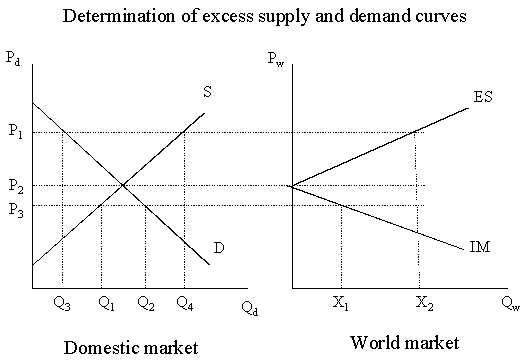
The position of the excess supply and demand curves will clearly shift if there are shifts in the underlying domestic supply and demand curves, but they will also shift if domestic policy drives a wedge between the world and domestic prices. For example, suppose that the world price is initially at P2 and the country is self-sufficient at this price. Suppose now that it introduces a policy of protection imposing a policy wedge of an absolute amount t, as a result of which it becomes an exporter (hence t implies an export subsidy). Note that, although the domestic price has changed, the world price has not. From the point of view of the rest of the world, this country has now become an exporter at the original world price level P2. This is shown by shifting the ES curve downwards by the amount t. Note that, by construction, this will ensure that the export quantity supplied at the world price P2 equals the export quantity available from the country following the introduction of the tariff. Similarly, if a country is an importer at the current world price, then the introduction of a tariff will lower its quantity of imports demanded, which will be reflected in a similar downward shift in the import demand curve IM.
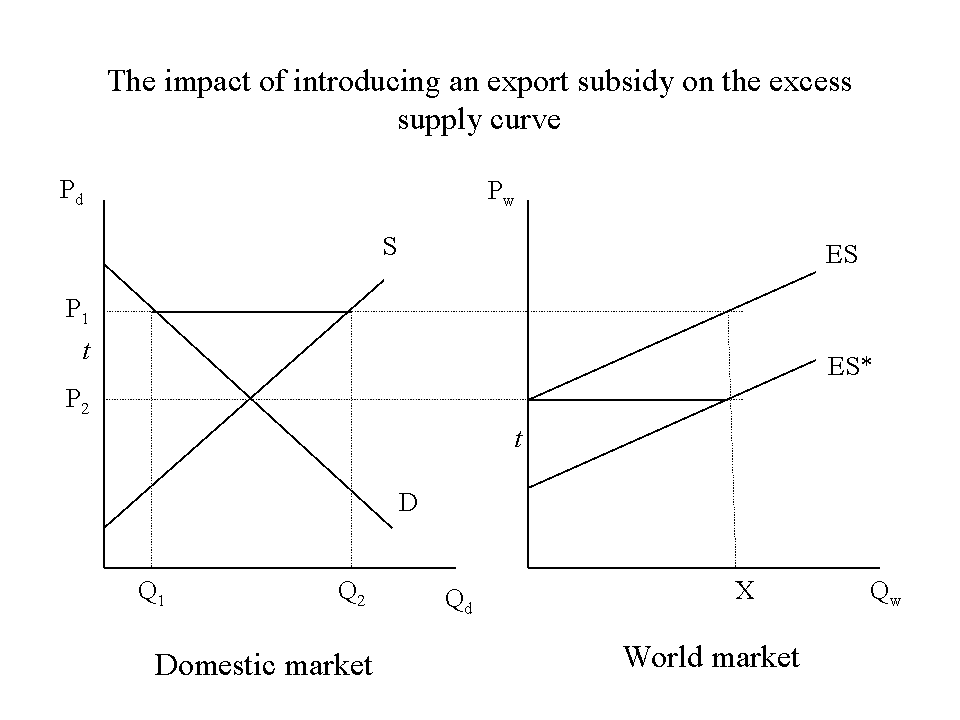
We are now in a position to show how the world market equilibrium is determined using excess supply and demand curves. Suppose we have two trading regions, an exporter (A) and importer (B). World market equilibrium is shown in the middle panel below as the interaction of A's export supply curve and B's import demand curve.
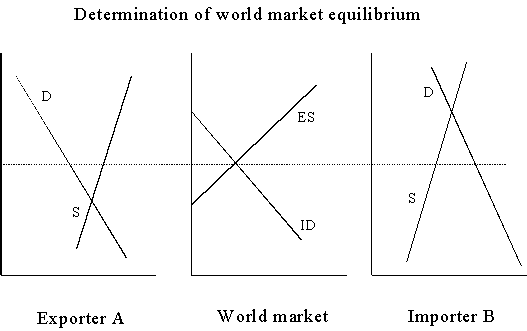
With this basic model it is possible to explore the most basic form of international dependence. If an adverse shock occurs in Country B, shifting its supply function to the left and raising prices, prices will also rise in Country A. An internal event in one country is transmitted to another country through changes in prices in the international market. See the McCalla and Josling reading for a graphical analyis of this effect.
Suppose the importing country B introduces a support policy for domestic producers by imposing a tariff t on imports. This shifts the import demand curve ID downwards, and lowers the world market price. We conclude that a country which raises producer prices to its own farmers lowers the price facing the rest of the world.
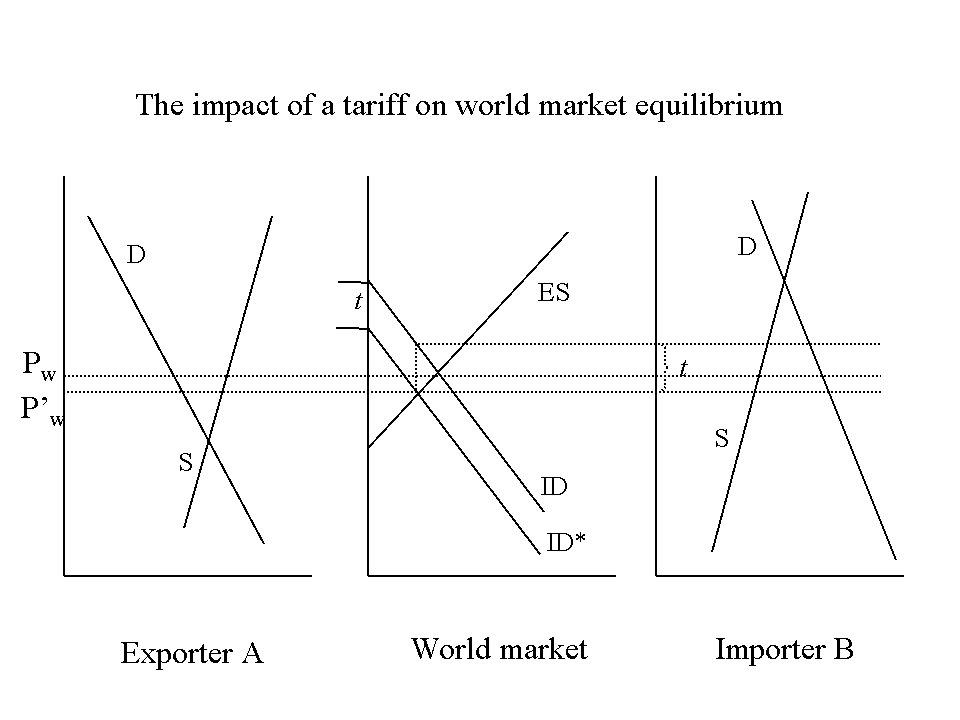
Note that the fall in world prices means that country B can now purchase its remaining import needs more cheaply, thus turning the terms of trade in its favour. This terms of trade effect gives rise to an additional welfare effect for a large country which introduces a policy of protection, which is positive for an importer but negative for an exporter.
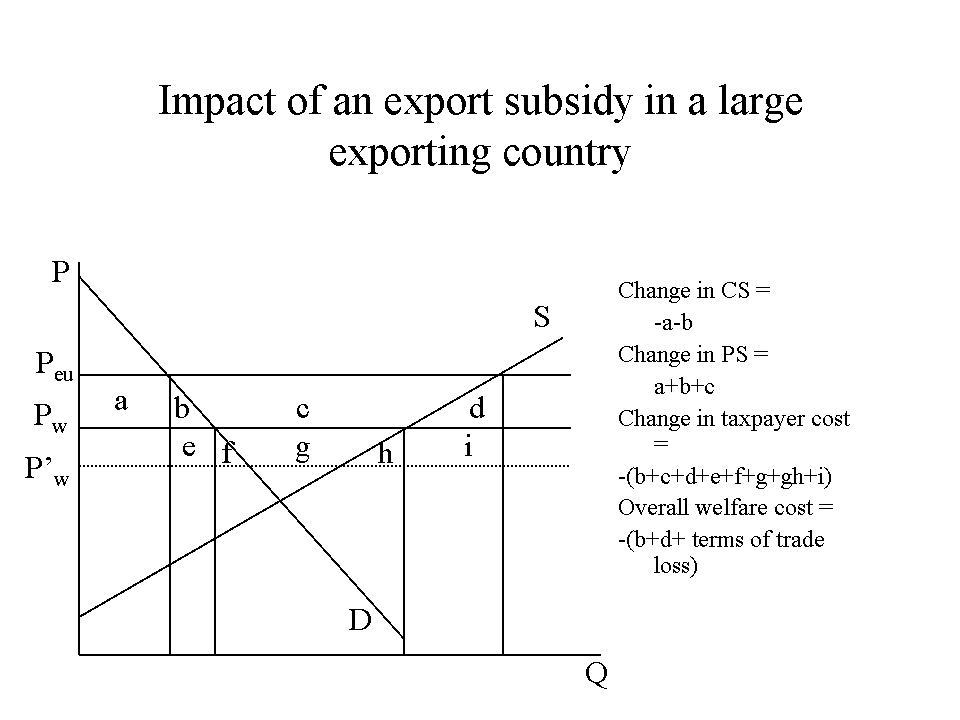
Here, the introduction of an export subsidy by a large exporting country results in a reduction in the world price from Pw to P'w. There is now an additional terms of trade cost for this country as compared to the situation where the world price is unchanged.
The model can easily be extended to more than two countries. The basic trick is to add the excess supply curves of net exporters together and the excess demand curves of net importers so that the model reduces to a two-region model in which the equilibrium world price is determined as above. The addition of more countries increases the slope of the trade functions relative to the slope of the individual country functions. Thus, even if there exists highly inelastic functions in individual countries, the responsiveness of the aggregate excess functions will be quite high in a market with many trading countries.
Suppose there is a shock in country B arising from a poor harvest. This shifts its domestic
supply curve to the left, and its import demand curve to the right. As a result, the equilibrium world market price
increases. This increased world market price is reflected in A's domestic market. While B's domestic price also
increases, note that it increases by less than if B was a closed economy. This illustrates both the benefits and
drawbacks of trade. Trade is a stabilising factor in the case of domestic shocks, but a destabilising factor in
the case of external shocks. Many countries are happy to rely on trade when it suits them (by importing to make
a food deficit caused by poor harvests, or exporting temporary gluts), but are fearful of importing instability
and try to insulate their domestic markets from external shocks. The more countries try to do this, the thinner
and more volatile the world market becomes, and the less willing countries are to open to the world market, thus
perpetuating the vicious circle. Fortunately, the empirical evidence shows that the variance of domestic shocks
is greater than the variance of external shocks; thus more open economies are, on balance, also more stable economies.
But if countries can free ride on the openness of other economies (by exporting their own instability but refusing
to import instability from the rest of the world) they can enhance their domestic stability further at other countries'
expense.
The EU's variable import levy/export subsidy system is a case in point. Note that the introduction of protection
can reduce the extent of price transmission between the world and domestic markets. In such cases, it not only shifts the
excess trade curves but it also rotates them. Perfect transmission implies that an x% change in world market prices
leads to a similar x% change in domestic prices. This would be the case under an ad valorem tariff, for example.
However, if a country chooses to use a specific tariff, then a given percentage change in world prices results
in a lower percentage change in domestic prices. In the extreme, if a country completely insulates its domestic
market from world market influence, for example, by guaranteeing a fixed domestic price regardless of the level
of the world market price, the degree of price transmission falls to zero. This is illustrated by a completely
vertical excess supply (demand) curve at whatever quantity represents the difference between domestic supply and
demand at the fixed domestic price.
To consider the impact of this policy on the stability of world market prices, let the EU export supply curve under
a policy of a fixed rate of protection be given by ESeu and its export supply curve under a policy of variable protection
(and a fixed internal price) be given by ES'eu. Suppose now that import demand in the rest of the world is volatile,
and the importing region experiences alternative good and bad harvests, reflected in its import demand curves ID1
(representing good harvests) and ID2 (representing a poor harvest). Observe that price volatility varies between
Pw2 and Pw3 when the EU adopts a fixed protection policy, but increases considerable to vary between Pw3 and Pw5
when the EU insulates its market from the rest of the world. This figure illustrates that a country which attempts
to stabilise its domestic market destabilises the world market for everyone else. In the case of the the EU, there
is also an ethical dimension to this policy. Rich countries (and rich consumers) are better able to withstand instability
than poor nations (and poor consumers).
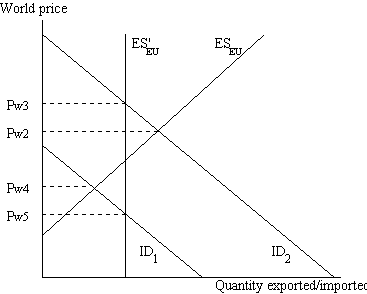
However, these conclusions need to be qualified in more realistic situations:
These qualifications make clear that it is not always possible to determine a priori even the direction of the effects of a particular policy or structural change which alters world prices, let alone their magnitude. As a result, there has been a strong growth of interest in empirical modelling of the impact of policy and structural changes on world food markets.
As McCalla and Josling point out, no country produces and consumes only one commodity. Therefore, policy analysis must attempt to take into account relevant intercommodity linkages and interdependencies. Examples of such interdependencies include:
The consequences of these interdependences are explored graphically in the McCalla and Josling reference below.
McCalla, A. and Josling, T., 1985, Agricultural
Policies and World Markets, London, Macmillan, Chapters 2 and 3.
(Chapter 2 covers the basic graphical analysis; Chapter 3 extends it to
the case where there are inter-relationships between commodities).
Gaisford, J. and Kerr, W., 2001. Economic Analysis for International Trade Negotiations:
The WTO and Agricultural Trade, Cheltenham, UK, Edward Elgar. Chapter 2.4, pp. 36-42 and Section 3.4, pp. 82-87..
(covers similar ground to the notes
above)
Supplementary reading
Tyers, R. and Anderson, K., 1992. Chapter 4 'The Theory of Food Market Distortions:
A Graphical Approach', in Disarray in World Food Markets,
Cambridge, Cambridge University Press.
(This chapter demands some effort to follow but makes a number of important
points about the effects of domestic policies on international prices)